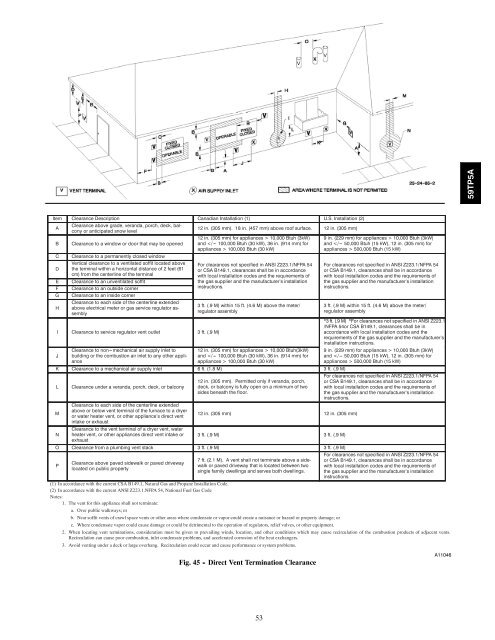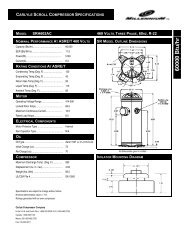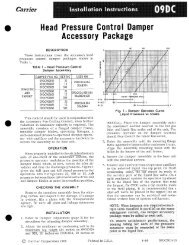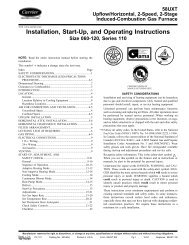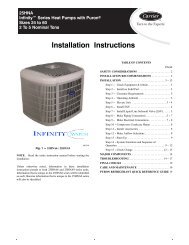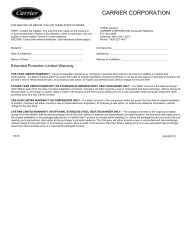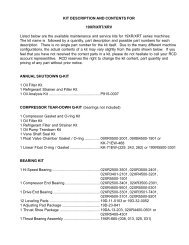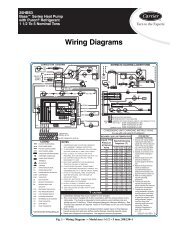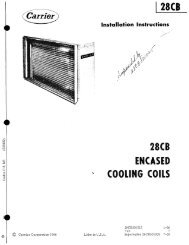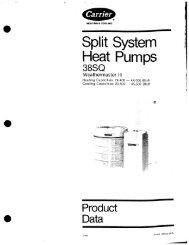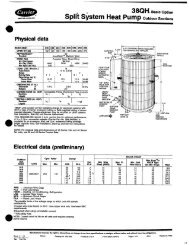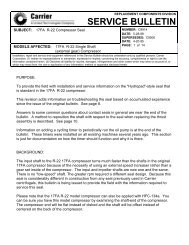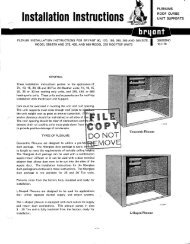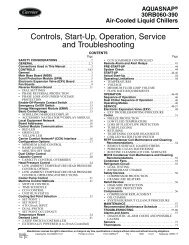warning - Docs.hvacpartners.com
warning - Docs.hvacpartners.com
warning - Docs.hvacpartners.com
You also want an ePaper? Increase the reach of your titles
YUMPU automatically turns print PDFs into web optimized ePapers that Google loves.
VV59TP5AItem Clearance Description Canadian Installation (1) U.S. Installation (2)AClearance above grade, veranda, porch, deck, balconyor anticipated snow level12 in. (305 mm). 18 in. (457 mm) above roof surface. 12 in. (305 mm)BCDEFGHClearance to a window or door that may be openedClearance to a permanently closed windowVertical clearance to a ventilated soffit located abovethe terminal within a horizontal distance of 2 feet (61cm) from the centerline of the terminalClearance to an unventilated soffitClearance to an outside cornerClearancetoaninsidecornerClearance to each side of the centerline extendedabove electrical meter or gas service regulator assemblyI Clearance to service regulator vent outlet 3ft.(.9M)JClearance to non---mechanical air supply inlet tobuilding or the <strong>com</strong>bustion air inlet to any other appliance12 in. (305 mm) for appliances > 10,000 Btuh (3kW)and 100,000 Btuh (30 kW)For clearances not specified in ANSI Z223.1/NFPA 54or CSA B149.1, clearances shall be in accordancewith local installation codes and the requirements ofthe gas supplier and the manufacturer’s installationinstructions.3ft.(.9M)within15ft. (4.6 M) abovethemeter/regulator assembly12 in. (305 mm) for appliances > 10,000 Btuh(3kW)and 100,000 Btuh (30 kW)K Clearance to a mechanical air supply inlet 6ft.(1.8M) 3ft.(.9M)LClearance under a veranda, porch, deck, or balcony12 in. (305 mm). Permitted only if veranda, porch,deck, or balcony is fully open on a minimum of twosides beneath the floor.MClearance to each side of the centerline extendedabove or below vent terminal of the furnace to a dryeror water heater vent, or other appliance’s direct vent12 in. (305 mm) 12 in. (305 mm)intake or exhaustNClearance to the vent terminal of a dryer vent, waterheater vent, or other appliances direct vent intake or 3ft.(.9M)3ft.(.9M)exhaustO Clearance from a plumbing vent stack 3ft.(.9M) 3ft.(.9M)PClearance above paved sidewalk or paved drivewaylocated on public property7 ft. (2.1 M). A vent shall not terminate above a sidewalkor paved driveway that is located between twosingle family dwellings and serves both dwellings.9 in. (229 mm) for appliances > 10,000 Btuh (3kW)and 500,000 Btuh (15 kW)For clearances not specified in ANSI Z223.1/NFPA 54or CSA B149.1, clearances shall be in accordancewith local installation codes and the requirements ofthe gas supplier and the manufacturer’s installationinstructions.3ft.(.9M)within15ft. (4.6 M) abovethemeter/regulator assembly*3 ft. (.9 M) *For clearances not specified in ANSI Z223.1/NFPA 54or CSA B149.1, clearances shall be inaccordance with local installation codes and therequirements of the gas supplier and the manufacturer’sinstallation instructions.9 in. (229 mm) for appliances > 10,000 Btuh (3kW)and 500,000 Btuh (15 kW)For clearances not specified in ANSI Z223.1/NFPA 54or CSA B149.1, clearances shall be in accordancewith local installation codes and the requirements ofthe gas supplier and the manufacturer’s installationinstructions.For clearances not specified in ANSI Z223.1/NFPA 54or CSA B149.1, clearances shall be in accordancewith local installation codes and the requirements ofthe gas supplier and the manufacturer’s installationinstructions.(1) In accordance with the current CSA B149.1, Natural Gas and Propane Installation Code.(2) In accordance with the current ANSI Z223.1.NFPA 54, National Fuel Gas CodeNotes:1. The vent for this appliance shall not terminate:a. Over public walkways; orb. Near soffit vents of crawl space vents or other areas where condensate or vapor could create a nuisance or hazard or property damage; orc. Where condensate vapor could cause damage or could be detrimental to the operation of regulators, relief valves, or other equipment.2. When locating vent terminations, consideration must be given to prevailing winds, location, and other conditions which may cause recirculation of the <strong>com</strong>bustion products of adjacent vents.Recirculation can cause poor <strong>com</strong>bustion, inlet condensate problems, and accelerated corrosion of the heat exchangers.3. Avoid venting under a deck or large overhang. Recirculation could occur and cause performance or system problems.Fig. 45 - Direct Vent Termination ClearanceA1104653


